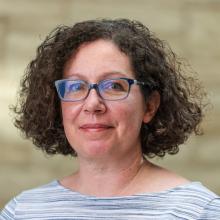The Department of Applied Mathematics is pleased to host this series of colloquium lectures, funded in part by a generous gift from the Boeing Company. This series will bring to campus prominent applied mathematicians from around the world.
Title: The Physics of Active Matter Systems through the Lens of the Quincke Rotor
Abstract: Active matter consists of systems composed of entities that harvest energy from their environment and convert it into motion. Flocks of birds and schools of fish are familiar examples, where individual units exhibit self-organization and coherent motion (“flow”) on scales far larger than the individual. Similar large-scale collective dynamics have been observed in self-propelled microscopic particles such as bacteria and motile colloids. In this talk, I will discuss the collective dynamics of active colloids powered by electric fields through the Quincke instability—the spontaneous spinning of a dielectric sphere in a uniform electric field. In free space, Quincke rotor dynamics are described by the Lorenz equations, making the system one of the physical realizations of Lorenz chaos. When constrained to a surface, the particles roll and become a model of self-propelled motion. I will present our experiments demonstrating how Quincke “rollers” can be engineered to perform run-and-tumble-like locomotion, mimicking bacterial swimmers such as E. coli. Populations of these Quincke random walkers self-organize and exhibit behaviors reminiscent of bacterial suspensions, including dynamic clustering and mesoscale turbulent-like flows, as well as novel emergent phenomena such as multi-vortex states. When confined within a drop, Quincke roller “swarms” drive pronounced shape fluctuations and drop motility resembling amoeboid crawling. I will discuss the mathematical modeling of this system, highlighting our progress on analytical solutions for single-particle dynamics near boundaries and the remaining challenge of simulating many-body hydrodynamic and electrostatic interactions in large confined populations.
Short bio: Petia M. Vlahovska is a Professor of Engineering Sciences and Applied Mathematics at Northwestern University. She received a PhD in Chemical Engineering from Yale University (2003) and MS in Chemistry from Sofia University, Bulgaria (1994). Her research encompasses fluid dynamics, soft matter physics, and cell biomechanics, driven by multidisciplinary challenges in materials science, cell and tissue engineering, robotics, neuromorphic engineering, and microgravity applications. Dr. Vlahovska has been recognized by several awards, including NSF Trailblazer Engineering Impact Award, Guggenheim Fellowship, Humboldt Fellowship for Experienced Researchers (Germany), NSF CAREER Award, and David Crighton Fellowship. Dr. Vlahovska is a Fellow of the American Physical Society (APS). She currently serves as an Associate Editor for the Journal of fluid Mechanics, the new SIAM Journal on Life Sciences, and Secretary/Treasurer of the ASP Division of Fluid Dynamics.
Video: Watch the talk on YouTube
